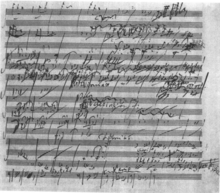Pastoral Symphony
| Symphony No. 6 | |
|---|---|
| by Ludwig van Beethoven | |

Part of a sketch by Beethoven for the symphony
|
|
| Other name | Pastoral Symphony |
| Key | F major |
| Opus | Op. 68 |
| Period | Classical period |
| Form | Symphony |
| Based on | Nature |
| Composed | 1802–1808 |
| Dedication | Archduke Rudolph |
| Duration | About 40 minutes |
| Movements | Five |
| Scoring | Orchestra |
| Premiere | |
| Date | December 22, 1808 |
| Location | Theater an der Wien, Vienna |
| Conductor | Ludwig van Beethoven |
The Symphony No. 6 in F major, Op. 68, also known as the Pastoral Symphony (German: Pastorale), is a symphony composed by Ludwig van Beethoven and completed in 1808. One of Beethoven's few works containing explicitly programmatic content, the symphony was first performed in the Theater an der Wien on 22 December 1808 in a four-hour concert.
Beethoven was a lover of nature who spent a great deal of his time on walks in the country. He frequently left Vienna to work in rural locations. The composer said that the Sixth Symphony is "more the expression of feeling than painting", a point underlined by the title of the first movement.
The first sketches of the Pastoral Symphony appeared in 1802. It was composed simultaneously with Beethoven's more famous—and more fiery—Fifth Symphony. Both symphonies were premiered in a long and under-rehearsed concert in the Theater an der Wien in Vienna on 22 December 1808.
The symphony is scored for the following instrumentation:
The symphony has five movements, rather than the four typical of symphonies of the Classical era. Beethoven wrote a programmatic title at the beginning of each movement:
The third movement ends on an imperfect cadence that leads straight into the fourth. The fourth movement leads straight into the fifth without a pause. A performance of the work lasts about 40 minutes.
The symphony begins with a placid and cheerful movement depicting the composer's feelings as he arrives in the country. The movement, in 2
4 metre, is in sonata form, and its motifs are extensively developed. At several points, Beethoven builds up orchestral texture by multiple repetitions of very short motifs. Yvonne Frindle commented that "the infinite repetition of pattern in nature [is] conveyed through rhythmic cells, its immensity through sustained pure harmonies."
...
Wikipedia
